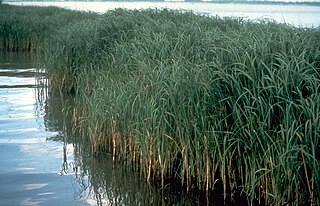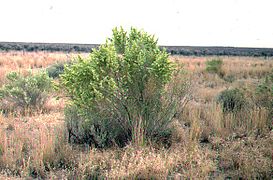Saltbush is a vernacular plantname that most often refers to:
Atriplex , a genus of about 250 plants distributed worldwide from subtropical to subarctic regions. Atriplex species occur natively in Australia, North & South America, and Eurasia. Many Atriplex species are halophytes and are adapted to dry environments with salty soils.
The genus Chenopodium is taxonomically a cousin of the genus Atriplex. Certain Chenopodiums may be called saltbushes. This includes Chenopodium robertianum and Chenopodium nutans .
Sarcobatus vermiculatus , native to North America, is a halophyte plant, and is sometimes informally called a saltbush.
Plants called saltbush
A halophyte is a salt-tolerant plant that grows in soil or waters of high salinity, coming into contact with saline water through its roots or by salt spray, such as in saline semi-deserts, mangrove swamps, marshes and sloughs and seashores. The word derives from Ancient Greek ἅλας (halas) 'salt' and φυτόν (phyton) 'plant'. An example of a halophyte is the salt marsh grass Spartina alterniflora. Relatively few plant species are halophytes—perhaps only 2% of all plant species.

The Chenopodioideae are a subfamily of the flowering plant family Amaranthaceae in the APG III system, which is largely based on molecular phylogeny, but were included - together with other subfamilies - in family Chenopodiaceae in the Cronquist system. Food species comprise Spinach, Good King Henry, several Chenopodium species, Orache, and Epazote.

Atriplex is a plant genus of 250–300 species, known by the common names of saltbush and orache. It belongs to the subfamily Chenopodioideae of the family Amaranthaceae s.l.. The genus is quite variable and widely distributed. It includes many desert and seashore plants and halophytes, as well as plants of moist environments. The generic name originated in Latin and was applied by Pliny the Elder to the edible oraches. The name saltbush derives from the fact that the plants retain salt in their leaves; they are able to grow in areas affected by soil salination.

Sarcobatus is a North American genus of two species of flowering plants, formerly considered to be a single species. Common names for S. vermiculatus include greasewood, seepwood, and saltbush. Traditionally, Sarcobatus has been treated in the family Chenopodiaceae, but the APG III system of 2009 recognizes it as the sole genus in the family Sarcobataceae.

Atriplex confertifolia (shadscale) is a species of evergreen shrub in the family Chenopodiaceae, which is native to the western United States and northern Mexico.

Atriplex cinerea, commonly known as grey saltbush, coast saltbush, barilla or truganini, is a plant species in the family Amaranthaceae. It occurs in sheltered coastal areas and around salt lakes in the Australian states of Western Australia, South Australia, Tasmania, Victoria and New South Wales.

Atriplex coronata is a species of saltbush known by the common name crownscale. It is endemic to California.

Atriplex lentiformis is a species of saltbush.

Atriplex nummularia is a species of saltbush from the family Amaranthaceae and is a large woody shrub known commonly as oldman saltbush. A. nummularia is native to Australia and occurs in each of the mainland states, thriving in arid and semi-arid inland regions.
Atriplex parryi is a species of saltbush known by the common name Parry's saltbush. It is native to the deserts and plateaus of eastern California and western Nevada.
Atriplex spinifera is a species of saltbush, known by the common names spiny saltbush and spinescale saltbush.
Atriplex watsonii is a species of saltbush known by the common name Watson's saltbush, or Watson's orach. It is native to the coastline of California and Baja California, where it grows in coastal areas with saline soils, such as salt marshes and beach scrub, with other halophytes such as saltgrass. It extends inland in the Los Angeles Basin, and along the Santa Ana River.

Chenopodium nutans, known by its common name of climbing saltbush or nodding saltbush, is a climbing groundcover native to Australia.

Chenopodium robertianum, known by the common name of saloop or berry saltbush is a small plant in the family Amaranthaceae. This species is found in coastal and inland areas of eastern Australia. Occasionally seen in rainforest gullies, though mostly seen in more open areas.

Atriplex gardneri is a species of flowering plant in the amaranth family known by the common name Gardner's saltbush. It is native to western North America from British Columbia to Saskatchewan in Canada south to Nevada and New Mexico in the United States. The specific epithet of the species, gardneri, is missnamed after its first collector, Alexander Gordon. The naturalist Alfred Moquin-Tandon was under the impression that Gordon's last name was Gardner.

Eriogonum visheri is a species of wild buckwheat known by the common names Dakota wild buckwheat and Visher's buckwheat. It is native to the Great Plains in the United States, where it is known from North Dakota, South Dakota, and Montana.
Atriplex acanthocarpa is a species of flowering plant in the amaranth family known by the common names armed saltbush, tubercled saltbush, and huaha. It is native to North America, where it is limited to the US states of Arizona, New Mexico, and Texas, and adjacent Mexico.

Greasewood is a common name shared by several plants:
Aeoloplides tenuipennis, known generally as the narrow-winged saltbush grasshopper or narrow-winged bush grasshopper, is a species of spur-throated grasshopper in the family Acrididae. It is commonly found in eastern California, Arizona and southwestern New Mexico north through Utah and southern Nevada to southern Idaho.

















